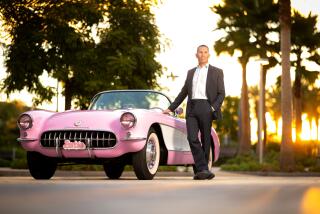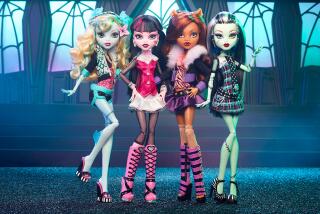Barbie breaks the mold with ethnically diverse dolls
- Share via
When Barbie was introduced to her young fans 57 years ago, she was more than a blond bombshell.
She was an astronaut, a doctor, a business executive — what every little girl in America could aspire to be.
But somewhere along the way, moms began to think that her impossibly thin body, out-of-proportion bust and sky-high stiletto pumps sent the wrong message to their daughters in an increasingly image-conscious world.
On Thursday, Barbie’s parents — Mattel Inc. — announced a move to bring her back as a role model for the 21st century.
She has three new body types that better reflect today’s woman: petite, curvy and tall. She’ll also come in seven skin tones, 22 eye colors and 24 hairstyles. Beauty, after all, comes in many shapes and sizes.
One Barbie has flowing blue hair and fuller hips. Another has a petite stature, dark skin and black curls piled in an updo. A few are Asian-looking, with almond-shaped eyes.
“These new dolls represent a line that is more reflective of the world girls see around them,” Evelyn Mazzocco, global general manager for Barbie, said in a statement. The variety “allows girls to find a doll that speaks to them.”
The fresh Barbies come as Americans are increasingly celebrating standards of beauty beyond the blond and blue-eyed look that Barbie defined for decades.
Celebrities like actress Rebel Wilson, reality TV star Kim Kardashian and even First Lady Michelle Obama have been held up as modern examples of what’s attractive. At the same time, the 2016 slate of Oscar nominees, who are mostly white, has jumpstarted the conversation about diversity.
With Barbie’s makeover, Mattel is trying to boost the brand’s sagging popularity. After dominating the doll aisle for decades, Barbie sales plunged in recent years as girls gravitated to Disney princesses and dolls with more sass and personality.
“When half of America is not Caucasian, you have to offer variety,” said Jim Silver, editor-in-chief of toy review website TTPM. “People want dolls that look like themselves.”
Barbie was once something of a revolutionary.
Launched in 1959, she was one of the first mass-produced and affordable adult dolls. She reflected the confidence that women had gained by working in America’s factories and farms while men fought overseas.
“In the early days, she represented American values and was presented as an example for women,” said Miro Copic, a marketing professor at San Diego State and former executive at toy maker Hasbro. “It was a great lesson for moms to talk to their daughters, ‘You can be what you want.’”
But that early empowerment message got lost during the consumerism of the 1980s and ‘90s, Copic said. The popularity of television and explosion of cable networks meant toy companies could target kids with 24/7 advertising.
Mattel introduced a slew of fashions and accessories for Barbie, targeting various age groups with different styles.
Her glamour overpowered rivals until Bratz arrived in 2001, analysts said.
Girls flocked to the pouty-lipped ethnically ambiguous dolls from MGA Entertainment, which snatched market share from Barbie.
Other toy makers hustled to introduce their own diverse doll lines.
That gave more options to parents, who wanted their kids to have role models who don’t fit a single, iconic image.
In recent years, Barbie’s tanking sales were a big factor in the El Segundo company’s reporting eight straight quarters of declining revenue.
“Barbie creates norms for what’s beautiful,” said Kim Elsesser, a lecturer at UCLA on gender and psychology. “But people started realizing that’s not how 99% of the world looks.”
Some mothers, like Francesca Pappagallo, actively avoided Barbies. When her daughter Liliana got an Elsa doll from the Disney hit movie “Frozen,” the 5-year-old declared that the doll was prettier than her.
“That’s exactly why I tried to avoid Barbies,” the Los Angeles resident said. “I don’t want her to think this is how her body should be. I don’t want the stick figure and boobies and weird eyes and weird hips.”
But the new versions may end the Barbie boycott.
“I have to see them in person,” Pappagallo said. “I might consider them now.”
The new Barbie, a huge step for Mattel, acknowledges that times have changed, analysts said.
“This is the appropriate evolutionary step to keep Barbie as a cultural icon for parents to buy for their kids,” Copic said.
Thursday’s announcement was an extension of Barbie’s Fashionistas line, which was rolled out last year. That included dolls with different eye shapes and skin tones.
So far, customers are responding. Silver said retailers have reported that the first wave of those ethnically diverse Barbies sold well during the holidays.
Erin Samaniego, 38, said she was pleasantly surprised by Barbie when shopping last year for her daughter Olivia.
The Target toy aisle, Samaniego said, had Barbies that were more realistic than what she remembered from childhood.
“There were brunettes and Latino and black Barbies,” the Camarillo resident said. “Honestly, I would go and buy one of each of those.”
Twitter: @ByShanLi
Times staff writer Michelle Maltais contributed to this report.
More to Read
Inside the business of entertainment
The Wide Shot brings you news, analysis and insights on everything from streaming wars to production — and what it all means for the future.
You may occasionally receive promotional content from the Los Angeles Times.











